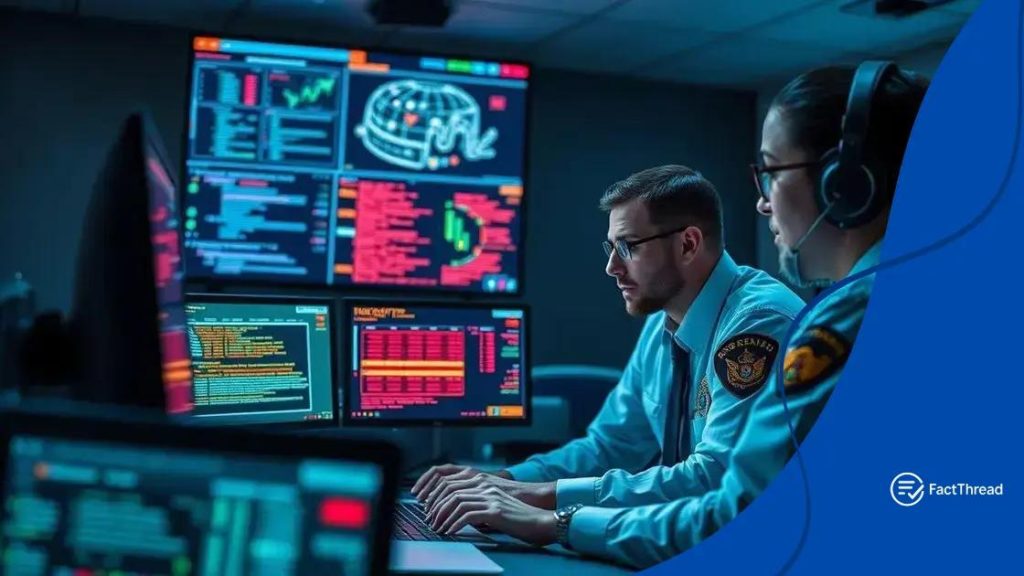Government responds to recent cyberattacks: what’s next?

The government responds to recent cyberattacks by implementing enhanced cybersecurity measures, fostering collaboration with the private sector, and focusing on education and awareness to better protect national infrastructure.
Government responds to recent cyberattacks by implementing new strategies aimed at protecting citizens and businesses. Are these measures enough to thwart future threats? Let’s delve into the details.
Overview of recent cyberattacks
In recent years, the threat of cyberattacks has escalated dramatically. Cybersecurity has become a crucial topic for governments and businesses alike. These attacks not only target sensitive information but also disrupt essential services.
Types of Cyberattacks
There are various types of cyberattacks, each with unique methods and implications. Understanding these types can help in preparing effective defenses. For example:
- Phishing: This involves tricking individuals into revealing sensitive data.
- Ransomware: Malicious software that locks files until a ransom is paid.
- DDoS attacks: Overloading a system with traffic to make it unavailable.
- Malware: Software specifically designed to disrupt, damage, or gain unauthorized access to systems.
These attacks can stem from various sources, including organized crime groups and state-sponsored hackers. The impact can be severe, resulting in financial losses and damaging the reputation of affected organizations.
Notable Recent Incidents
Several significant cyberattacks have shocked the world in the past year. One major incident involved a large healthcare provider, resulting in the exposure of personal patient data.
In another case, a vital national infrastructure was compromised, leading to widespread service disruptions. Such incidents highlight the vulnerability of both private and public sectors to cyber threats.
As governments work to enhance their cybersecurity, public awareness is equally essential. Citizens must be informed about how to protect themselves online. Simple practices like using strong passwords and recognizing phishing attempts can go a long way.
Ultimately, staying informed about recent cyberattacks can empower individuals and organizations to take proactive measures. By understanding the evolving landscape of cyber threats, we can better prepare for future attacks and minimize their potential impact on society.
Immediate government actions taken
Following the surge in cyberattacks, the government has swiftly implemented several crucial measures to bolster national cybersecurity. These immediate actions aim to protect sensitive information and ensure the safety of vital infrastructure.
Establishment of Cybersecurity Task Forces
One of the first steps taken was the formation of dedicated task forces. These teams consist of experts in cybersecurity, law enforcement, and intelligence. Their primary goal is to assess threats and coordinate responses efficiently.
- Collaboration with law enforcement officials.
- Regular updates on emerging threats.
- Implementation of rapid response protocols.
- Engagement with private sector partners.
This collaboration is essential for a unified defense against cyber threats. By sharing information and resources, the government can respond more effectively to incidents.
Enhanced Funding for Cybersecurity Programs
The government has also allocated significant funding to strengthen existing cybersecurity programs. This includes investments in advanced technologies that can detect and neutralize threats before they escalate.
In addition to technological upgrades, training programs for personnel dealing with cybersecurity are being enhanced. These initiatives focus on raising awareness of common threats and improving response strategies.
Another crucial area of focus has been public awareness campaigns. The government is actively promoting best practices for individuals and businesses to protect themselves from cyber threats. Simple actions, such as updating software and using strong passwords, can greatly reduce vulnerability.
All these efforts reflect a comprehensive approach to addressing the growing threat of cyberattacks. Through immediate and decisive actions, the government aims to create a safer environment for both citizens and the digital economy.
Strategies for improving national cybersecurity

To enhance national cybersecurity, various strategies are being adopted by governments and organizations. These measures aim to strengthen defenses against evolving cyber threats. Coordination among different sectors is vital, as attacks can come from various sources.
Investment in Advanced Technologies
One key strategy involves investing in advanced technologies that can identify and neutralize threats quickly. These include:
- Artificial Intelligence: AI can analyze patterns and detect anomalies much faster than humans.
- Machine Learning: Systems that learn from data can improve defenses over time.
- Blockchain Technology: This offers secure and transparent record-keeping that can enhance data integrity.
- Firewalls and Intrusion Detection Systems: These tools are crucial for monitoring and protecting networks.
Sophisticated tools can automate responses to threats, thereby reducing response times and minimizing damage.
Training and Awareness Programs
Another essential aspect is educating employees and the public about cybersecurity risks. Training programs should teach individuals how to recognize potential threats, such as phishing attacks. These programs can significantly improve overall cyber hygiene.
Awareness campaigns can inform users about:
- Secure password practices.
- Recognizing suspicious emails and links.
- Safe browsing habits.
- The importance of regular software updates.
Equipping people with knowledge is crucial, as users often serve as the first line of defense against cyber threats. With better awareness, they can help prevent attacks.
Collaboration between the public and private sectors is fundamental to enhancing cybersecurity. By sharing information and intelligence, organizations can develop more effective solutions to combat cyber threats.
Regular updates and adaptive strategies will ensure that cybersecurity measures remain effective against new tactics employed by cybercriminals. A proactive approach is essential for maintaining a secure digital environment.
Role of private sector in cybersecurity
The private sector plays a crucial role in enhancing cybersecurity on a national level. Businesses are often the targets of cyberattacks, making their involvement essential in the fight against these threats. By implementing strong security measures, they help safeguard not only their data but also the information of their customers.
Collaboration with Government Agencies
One way the private sector contributes is through collaboration with government agencies. Partnerships allow for the sharing of critical information about threats and vulnerabilities. This exchange enables both parties to stay ahead of cybercriminals.
- Joint cybersecurity exercises: These drills help organizations prepare for potential attacks.
- Information sharing platforms: These allow real-time updates on threats and breaches.
- Policy development: Together, they can create effective regulations that enhance security.
- Research initiatives: Collaborating on advanced cybersecurity technologies can lead to innovative solutions.
By working collaboratively, both sectors can strengthen defenses against evolving threats.
Investment in Cybersecurity Measures
The private sector also invests heavily in cybersecurity technology. Companies are adopting cutting-edge solutions to protect their systems and sensitive data. This includes:
- Firewalls and intrusion detection systems: Essential tools for monitoring network activity.
- Anti-virus and anti-malware software: Programs that detect and eliminate malicious threats.
- Employee training programs: Teaching staff to recognize potential threats and how to respond.
- Encryption technologies: Protecting data in transit and storage.
These investments demonstrate a commitment to maintaining secure environments and minimizing vulnerabilities.
Moreover, businesses often lead the way in developing new technologies that advance cybersecurity. Startups and established firms alike work on innovative solutions that can benefit various industries. By prioritizing cybersecurity, they reduce the risk of breaches and increase trust among customers.
As cyber threats continue to grow, the partnership between the private sector and governmental bodies will be vital. A unified approach allows for a more robust defense against the evolving landscape of cyber risks, fostering a safe digital environment for everyone.
Looking ahead: future challenges and solutions
As we look ahead, the landscape of cybersecurity presents both challenges and opportunities. Cyber threats are constantly evolving, making it essential to stay vigilant and proactive in addressing emerging risks. Understanding these challenges can help organizations develop effective solutions.
Adapting to New Technologies
One major challenge is adapting to advance technologies. As businesses integrate more tools like artificial intelligence and the Internet of Things (IoT), vulnerabilities may arise. Ensuring that these technologies are secure is critical.
- IoT devices: Many IoT devices have limited security, making them easy targets for attackers.
- AI vulnerabilities: While AI can enhance security, it can also be manipulated to execute attacks.
- Cloud security: As more businesses move to the cloud, safeguarding data in this environment is crucial.
- Remote work security: The shift to remote work has created new challenges for securing corporate networks.
Organizations must continuously adapt their cybersecurity measures to keep pace with these technologies.
Emerging Threats and Cybercriminal Tactics
In addition to technology challenges, emerging threats are becoming more sophisticated. Cybercriminals are using advanced techniques to execute attacks, including:
- Machine learning for phishing: Attackers use machine learning to create more convincing phishing emails.
- Ransomware-as-a-Service: Cybercriminals can now purchase ransomware tools, making it easier for anyone to launch attacks.
- Supply chain attacks: Targeting third-party vendors can lead to breaches in larger organizations.
- State-sponsored attacks: These are increasingly sophisticated and can have significant economic and political implications.
Staying ahead of these tactics requires constant vigilance and updating security strategies.
One effective way to tackle these challenges is through collaboration. By sharing information about threats and best practices, organizations can build a stronger defense. Partnerships between governments and the private sector can enhance intelligence sharing.
Education also plays a vital role. Training employees can help them recognize potential threats and respond appropriately. Organizations should invest in ongoing education to ensure everyone is aware of best cybersecurity practices.
Ultimately, the future of cybersecurity will depend on a proactive stance. By understanding potential challenges and implementing innovative solutions, organizations can create a more secure environment. Emphasizing collaboration, education, and technology adaptation will be key in combating future cyber threats.
FAQ – Frequently Asked Questions about Cybersecurity Challenges and Solutions
What are the main challenges in cybersecurity today?
The main challenges include adapting to new technologies, emerging cyber threats, and ensuring data protection across various platforms.
How can organizations enhance their cybersecurity measures?
Organizations can enhance their measures by investing in advanced technologies, training employees, and collaborating with government agencies.
What role does the private sector play in cybersecurity?
The private sector is essential for providing innovative solutions, sharing information on threats, and investing in robust security measures.
Why is education important in cybersecurity?
Education helps employees recognize potential threats, improves their response to incidents, and fosters a culture of security awareness within organizations.